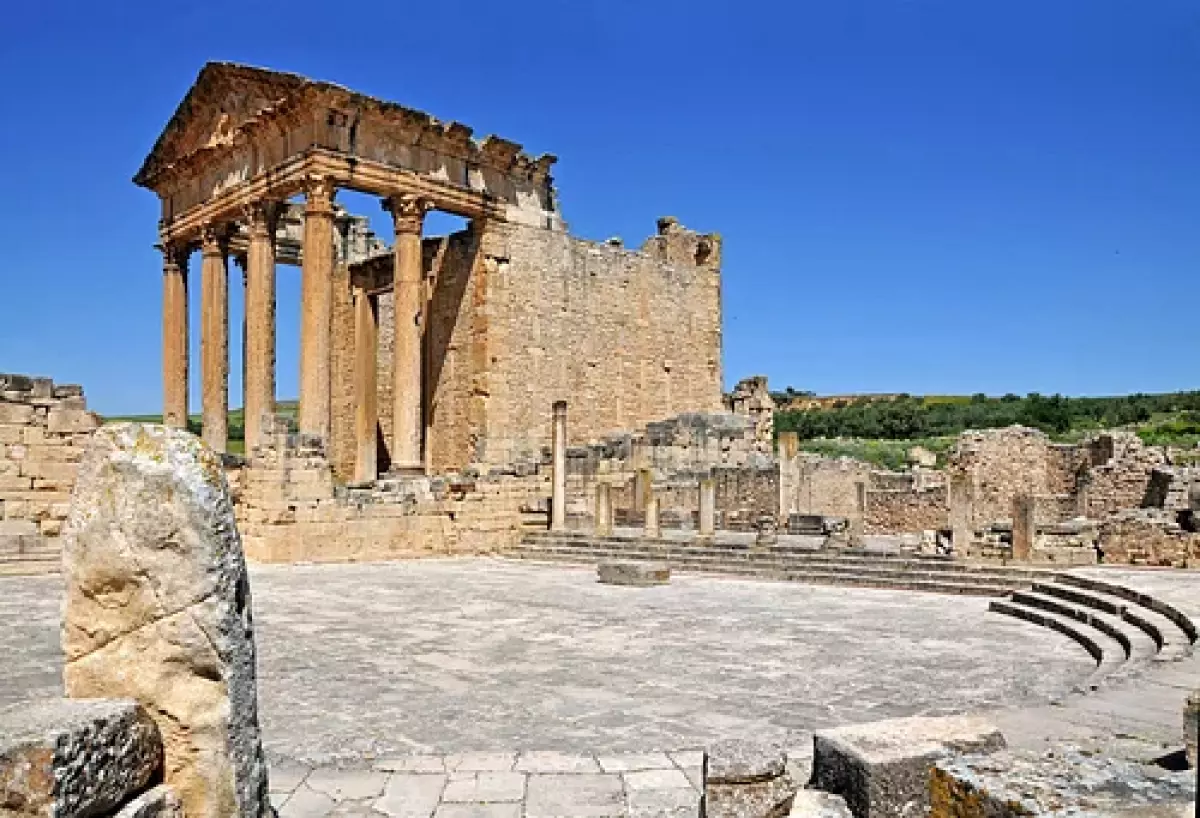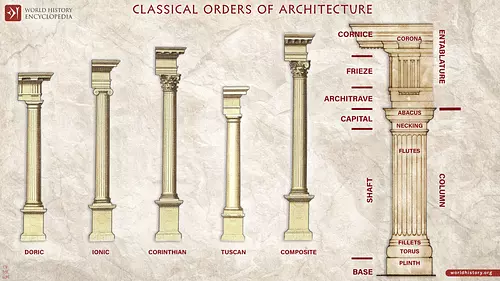 Capitolium, Thugga (by Dennis Jarvis, CC BY-SA)
Capitolium, Thugga (by Dennis Jarvis, CC BY-SA)
Roman architecture, influenced by the Greeks, took architectural innovation to new heights. The Romans combined creative design with new construction techniques and materials, resulting in a wide range of groundbreaking structures. From grand basilicas to monumental aqueducts, their architectural marvels were a testament to their ingenuity and the changing needs of Roman society.
The Architectural Orders
Roman architects followed the classical orders established by the Greeks. The Corinthian order was particularly favored and gave Roman buildings a distinct Greek look. The Romans added their own unique touches, such as a more decorative Corinthian capital and cornice. They also created the composite capital, which combined the volute of the Ionic order with the acanthus leaves of the Corinthian. Another Roman adaptation was the Tuscan column, a more slender version of the Doric column with a smaller capital and a molded base. Monolithic columns, instead of using stacked drums, became a preferred choice for the Romans.
 Architectural Column Orders
Architectural Column Orders
Greek influence in Roman architecture extended to innovative structures like the basilica and bath buildings, which first appeared in southern Italy. The Romans took these ideas and expanded upon them, incorporating towering arches and domes into their imperial bath complexes. The use of arches and columns created impressive interior spaces that defied the limits of construction.
Materials & Techniques
Marble became the material of choice for grand Roman buildings. Carrara marble from Tuscany, Parian marble from the Cyclades, and Pentelic marble from Athens were highly esteemed. The Romans also favored colored varieties like yellow Numidian marble, purple Phyrgian marble, red porphyry, and green-veined Carystian marble. Travertine white limestone, known for its precise carving and strength, served as a substitute for marble.
 Columns of Hagia Sophia
Columns of Hagia Sophia
Concrete, a material the Romans perfected, revolutionized architecture. By using lime mortar mixed with stone aggregate, known as opus caementicium, the Romans created a versatile material that could support great weight. Concrete allowed for the construction of massive structures like the Sanctuary of Fortuna Primigenia at Palestrina. Additionally, the use of pozzolana, a type of volcanic sand, made the concrete even stronger and capable of setting underwater.
Fired bricks, made of various colors, were commonly used for their durability. They could be carved like stone to mimic architectural features such as capitals and dentils. Stucco, made from sand, gypsum, and marble dust, provided a decorative facing for brick walls. Other materials like volcanic tufa, pumice, basalt, and terracotta were used for specific purposes, such as domes and ornamentation.
Roman Architects
While many Roman architects remain anonymous, their designs and visions live on in their projects. Notable architects, such as Apollodorus of Damascus and Severus and Celer, oversaw iconic structures like Trajan's Forum and the Golden House of Nero. Vitruvius, the renowned author of "On Architecture," is celebrated for his comprehensive study of the field. His work emphasizes the importance of durability, utility, and beauty in all buildings.
Key Roman Buildings
Roman architecture produced a diverse range of impressive structures that still inspire awe today.
Aqueducts & Bridges - These colossal structures transported fresh water to urban centers, with the Pont du Gard near Nimes being the most magnificent example.
Basilicas - Originally used as law courts, basilicas were large gathering places featuring a central nave flanked by columns and piers. The Severan Basilica at Lepcis Magna showcases this design.
Baths - Roman baths exhibited breathtaking interior spaces with arches, domes, vaults, and buttresses. The Baths of Caracalla in Rome exemplify the luxuriousness of these complexes.
Private Homes - Roman residences were adorned with frescoes and stucco, complemented by atriums, peristyles, gardens, and fountains. The House of the Vettii at Pompeii epitomizes the grandeur of these homes.
Theatres & Amphitheatres - Roman theatres, featuring semicircular orchestra spaces and decorative stage buildings, were often roofed. Amphitheatres, like the Colosseum, were fully enclosed structures designed for gladiatorial spectacles.
Triumphal Arches - Triumphal arches commemorated significant events with their impressive sculptures and inscriptions. The Arch of Constantine in Rome is a renowned example.
Temples - Roman temples combined Etruscan and Greek architectural elements, with an emphasis on a focal point and surrounding columns. The Maison Carrée at Nimes embodies this design.
Walls - Roman walls displayed various styles, from ashlar masonry utilizing stone blocks to different types of brickwork, such as opus reticulatum and opus vittatum. Plaster stucco protected the walls from the elements and provided a smooth surface for interior wall paintings.
From their innovative use of materials to their daring designs, Roman architects pushed the boundaries of architecture. Their structures not only showcased the might of the Roman Empire but also left a lasting impact on Western architecture. Roman architecture continues to inspire awe and admiration, standing as a testament to the ingenuity and creativity of the ancient Romans.









